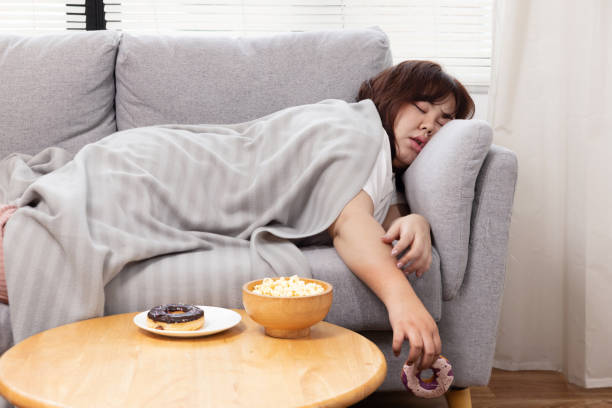Introduction

For those living with Parkinson's Disease, getting a good night's sleep can be incredibly difficult. With the disorder causing insomnia, leg cramps, and tremors, many people find falling or staying asleep throughout the night hard. Yet despite this challenge, proper rest is essential for maintaining one's physical and mental health and improving how one manages disease symptoms.
That said, creating a sleep-conducive environment is key to helping those with Parkinson's get some much-needed shuteye — so in this blog post, you will learn what to do (or not do) when prepping your bedroom for better snoozing!
6 Ways to Create a Sleep-Conducive Environment for Parkinson's Patients
Here are six key tips for creating a sleep-conducive environment for Parkinson's patients.
1 . Create a relaxing atmosphere in the bedroom with dim lighting and a comfortable temperature.

Creating a relaxing atmosphere in the bedroom is essential for helping Parkinson's patients sleep better. Dim lighting helps promote relaxation and restful sleep while alleviating some symptoms of Parkinson's disease, such as tremors and insomnia.
Additionally, maintaining a comfortable temperature in the bedroom can help reduce nighttime sweating and discomfort that can interfere with restful sleep.
To create a relaxing atmosphere in the bedroom, opt for ambient lighting fixtures and keep lamps and other light sources out of sight to reduce glare. Incandescent bulbs are preferable over fluorescent lights because they emit soothing, yellow-toned light.
Use blackout curtains or blinds to darken the room and block out noise. Aromatherapy can also help calm the nerves and reduce the stress that can interfere with sleep.
The ideal temperature for a bedroom should be between 60-67 degrees Fahrenheit (15-19 Celsius). Consider fluctuations in temperature caused by changing weather, adjusting the thermostat accordingly.
Use a room thermostat that can be customized to an individual's preferences. Humidifiers can also help relieve symptoms like dry skin, coughing, and difficulty breathing by maintaining a comfortable humidity level in the bedroom.
By creating a relaxing atmosphere with dim lighting and comfortable temperature, Parkinson's patients will find it easier to fall asleep and stay asleep. With regular, restful sleep, patients can experience improved cognitive function and quality of life.
Additionally, a good night's sleep will help reduce the intensity of Parkinson's disease symptoms, such as tremors and stiffness. These tips for creating an optimal sleeping environment can help make a huge difference for Parkinson's patients.
2 . Incorporate gentle white noise or calming music to help provide a distraction from outside noises.

Incorporating gentle white noise or calming music into the bedroom of a Parkinson's patient can be an effective way to help provide a distraction from outside noises and create a sleep-conducive environment.
White noise is defined as sound with a consistent frequency across all audible frequencies, which helps to reduce fluctuations in background noise that could interfere with sleep. Calming music, such as classical or instrumental pieces, can also help provide a distraction from outside noises and help Parkinson's patients relax into a restful state.
White noise machines are the ideal option for creating a consistent soundscape in the bedroom of a Parkinson's patient. These devices produce consistent sound without variation, making it easier to tune out disruptive noises.
Additionally, some white noise machines have additional features such as adjustable volume control and timer settings, making them even more conducive to creating a restful sleeping environment.
Alternatively, calming music can be just as effective in distracting from outside noises. Choose instrumental music with slow and steady tempos to create a peaceful atmosphere in the bedroom. Additionally, it is important to choose music with low volume levels as louder volumes can be jarring and interfere with restful sleep.
Music therapy has even been beneficial for Parkinson's patients, as studies have shown that it can help reduce stress and improve quality of life. Additionally, music bright light therapy can help reduce symptoms such as tremors, rigidity, and slow movements.
3 . Reduce electromagnetic frequencies from electronics that could interfere with sleep.
Reducing Electromagnetic Frequencies from Electronics to Enhance Sleep Quality for Parkinson's Patients
Electronic devices in the bedroom can disrupt sleep, emitting electromagnetic frequencies (EMFs) that can interfere with our body's natural rhythms. For this reason, it is important to take steps to reduce the EMF levels in the bedroom of a Parkinson's patient.
Step One: Remove Electronic Devices From the Bedroom
The first step to reducing EMFs is removing electronic devices from the bedroom. This includes TVs, cellphones, tablets, laptops, and other electronic devices that emit radiation. Additionally, it is important to unplug any electronic devices, such as lamps and alarm clocks, that are plugged in but not in use.
Step Two: Place Wireless Routers and Power Strips Away from the Bedroom
Wireless routers, which provide the internet connection to most homes and offices, also emit electromagnetic frequencies. It is important to place these routers away from the bedroom, ideally in a room used less often.
Additionally, it is important to ensure that any power strips are placed away from the bedroom and not directly adjacent to the bed.
Step Three: Invest in EMF Shielding Products
Investing in EMF shielding products can effectively reduce the EMF levels in the bedroom of a Parkinson's patient. These products are designed to block or absorb radiation from electronic devices, which can help reduce the EMF levels in the bedroom.
Shielding blankets and curtains are available for purchase and can be placed around beds or hung on walls to block radiation. Additionally, some companies offer EMF shielding materials that can be used to line walls and create a protective barrier around the bedroom.
Step Four: Prioritize Low-EMF Electronics
Choosing products with low-EMF ratings is important when shopping for new electronic devices. Look for products labeled as "low-EMF" or "EMF-shielded," and avoid products with high EMF ratings. Additionally, reading the product manual before using a new electronic device is important, as some devices may have specific instructions for reducing their EMF emission levels.
4. Place clocks away from the bed so they don't cause any distracting disruption.

Placing Clocks Away From the Bed to Enhance Sleep Quality for Parkinson's Patients .Having a clock in the bedroom can benefit Parkinson's patients, as it can provide structure and help them keep track of time more easily. However, having a clock too close to the bed can be disruptive and cause sleep disturbances. For this reason, it is important to place clocks away from the bed to ensure restful sleep for Parkinson's patients.
Here are some tips for placing a clock away from the bed:
• Place the clock on a dresser or shelf at least 2 feet from the bed.
• Choose a clock with a dim display that is easy to read but not too bright.
• Place the clock in an area with minimal noise, such as away from windows or other sound sources.
• Make sure the clock is visible and accessible, so it can be easily read without disrupting sleep. • If possible, purchase a clock with a timer or alarm function set to go off at specific times.
• Consider investing in an app-based clock that can be adjusted and monitored remotely from a smartphone or tablet.
5 . Use aromatherapy oils to promote relaxation and reduce stress.
Aromatherapy is an effective way to reduce stress and promote relaxation for Parkinson's patients. Aromatherapy oils, such as lavender, chamomile, and sandalwood, have calming and soothing properties that can help relax the body and mind. Additionally, these oils can be used to create a pleasant atmosphere in the bedroom that is conducive to restful sleep.
When using aromatherapy oils, it is important to keep safety in mind. Aromatherapy products should be purchased from a reputable source and diluted before use.
For example, the essential oil can be added to a diffuser, humidifier, or bathtub filled with warm water. Additionally, avoiding using essential oil directly on the skin is important as some may cause irritation or an allergic reaction.
Finally, when adding aromatherapy oils to the bedroom of a Parkinson's patient, it is important to remember that scent preferences can vary. It is best to test out different scents and find one the patient enjoys. Once a scent has been chosen, the aroma can promote relaxation before bedtime or throughout the day.
Moreover, using an aromatherapy diffuser with light and sound settings can add extra relaxation benefits. With these simple tips, aromatherapy can reduce stress and create a sleep-conducive environment for Parkinson's patients.
6 . Purchase a specialized mattress for Parkinson's patients to ensure proper support and comfort.
Getting a good night's sleep is essential for Parkinson's patients, and investing in the right mattress can help ensure they get the restful sleep they need. Specialized mattresses designed specifically for Parkinson's patients are available on the market and provide superior support and comfort.
When choosing a mattress for a Parkinson's patient, it is important to consider factors such as body size and weight, sleeping position, and medical condition. A firmer mattress may benefit a Parkinson's patient by providing better back support and reducing the risk of developing pressure sores. Firmer mattresses are also easier to move on.
Memory foam mattresses are often recommended for Parkinson's patients as they are designed to conform to the body and support pressure points. Memory foam mattresses also have a slower response time, which can benefit those with mobility issues. However, when the body sinks into the foam it can be more difficult to change positions. It is advisable to take advantage of trial periods to identify the most important features for yourself.
Finally, looking for a mattress that offers temperature regulation is important. This can help keep the patient cool and comfortable throughout the night and prevent sweating.
Sleep Issues in Parkinson's Disease and Their Management
Here are some steps to creating a sleep-conducive environment for Parkinson's patients:
1. Establish Regular Sleep Routines: Regular bed and wake times and consistent pre-bed rituals such as reading, listening to soothing music, or taking a warm bath can help build habits that will aid in reducing excessive daytime sleepiness.
2. Reduce Stimulants: Caffeine, nicotine, and certain medications can disturb sleep fragmentation in Parkinson's patients. Reducing or eliminating them is important to creating a safe and restful environment.
3. Adjust the Room Temperature: A comfortable temperature (cooler than what people without Parkinson's Disease prefer) can improve sleep quality.
4. Block Out Noise and Light: Make sure the room is dark and quiet using blackout curtains, eye masks, earplugs, or noise-canceling headphones.
5. Avoid Naps During the Day: If possible, try to nap during the day – it could reduce nighttime wakefulness and the need for daytime sleepiness pills.
6. Regularly: Exercise during the day can help you feel more tired and sleep disorders
at night, leading to better rest.
Creating a sleep-conducive environment is important in managing the symptoms of Parkinson's Disease, so try these steps to ensure that your patient gets the best night's sleep-wake cycle possible. With the right environment, Parkinson's patients can get quality rest and wake up feeling refreshed.
7. Use Assistive Devices: Assistive devices such as leg lifts, mattresses, or pillows are designed to reduce pain or discomfort caused by Parkinson's Disease sleep scale quality. Talk to your doctor or physical therapist about any assistive devices that may be beneficial.
8. Talk to a Doctor: If sleep disorder issues persist, talk to your doctor about medications and other therapies that could help improve sleep quality.
Creating a restful environment is an important part of managing the symptoms of Parkinson's Disease. With these steps, patients can get the rest they need to keep their symptoms in check.
FAQ's
What is a natural approach to Parkinson's?
A natural approach to Parkinson's involves lifestyle modifications such as maintaining a healthy diet, exercising regularly, reducing stress, and creating a poor sleep quality environment. Additionally, some supplements may be beneficial in managing symptoms.
What activities help with Parkinson's?
Regular physical activity can help improve balance, mobility, and coordination in Parkinson's patients. Walking, biking, swimming, yoga, and tai chi can all be beneficial. Cognitive activities such as reading or playing board games can also enhance mental alertness and reduce fatigue.
Why can't people with Parkinson's sleep at night?
People with Parkinson's may experience difficulty sleeping at night due to symptoms such as muscle rigidity or tremor. Additionally, medications used to manage the disease can cause restlessness or insomnia severity index. Establishing regular sleep routines and creating a sleep-conducive environment to get quality rest is important.
How can I boost my energy with Parkinson's?
Boosting energy in Parkinson's patients can be achieved through lifestyle modifications such as exercising regularly, maintaining a healthy diet, sleep-disordered breathing, and getting adequate rest. Additionally, some medications may also help improve energy levels. Talk to your doctor about treatments or therapies that could help boost your energy.
Does lack of sleep make Parkinson's worse?
Yes, lack of sleep can make Parkinson's symptoms worse. Regular sleep routines and a restful environment are important for quality rest. Talk to your doctor about any treatments or therapies that could help improve sleep dysfunction quality.
Which fruit is good for Parkinson's?
Fruits high in antioxidants, like blueberries and strawberries, can benefit Parkinson's patients. Additionally, getting adequate Vitamin C from foods like oranges, restless legs syndrome, and grapefruits helps manage disease symptoms. Talk to your doctor about dietary changes that could help improve overall health.
Conclusion
I hope this article has given you a better understanding of creating a sleep-conducive environment for Parkinson's patients. Creating the right environment and establishing regular routines can help improve sleep quality, rem sleep behavior disorder, obstructive sleep apnea, leading to better overall health.
If symptoms are not improving with lifestyle modifications, talk to your doctor about any medications or therapies that could be beneficial. By taking these steps, Parkinson's patients can get the rest they need to keep

